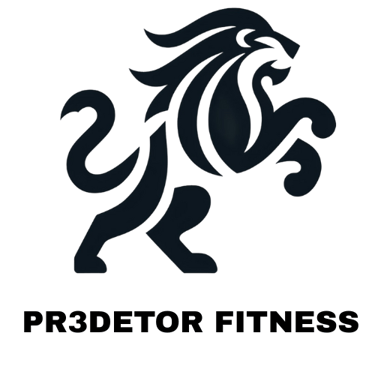Unlocking the Power of the Front Deltoid: Essential Insights!
"From the Front"
Coach Gabe
2/3/20257 min read


Understanding the Front Deltoid
The front deltoid, also known as the anterior deltoid, is a crucial muscle located in the shoulder region. Anatomically, it is one of three distinct heads of the deltoid muscle, which collectively gives the shoulder its rounded appearance. The anterior deltoid originates from the lateral one-third of the clavicle, extending to insert on the deltoid tuberosity of the humerus. This specific positioning allows the front deltoid to play a vital role in shoulder movements and overall upper body functionality.
Primarily, the front deltoid is responsible for shoulder flexion, which involves raising the arm forward. This action is fundamental in numerous weightlifting exercises, including the bench press, shoulder press, and various forms of flyes. In addition to shoulder flexion, the front deltoid assists in internal rotation and abduction of the arm. As a result, well-developed front deltoids contribute significantly to upper body strength and stability, making them essential for performing daily activities and athletic endeavors alike.
The strength and endurance of the front deltoid are particularly critical in weightlifting. A strong anterior deltoid allows an individual to lift heavier loads while maintaining proper form and control. Therefore, understanding the role of the front deltoid is imperative for anyone looking to enhance their weightlifting performance. Careful attention to this muscle during training can lead to improved posture, increased lifting efficiency, and reduced injury risk. Therefore, athletes and fitness enthusiasts alike should consider integrating targeted exercises that focus on this muscle into their workout routines.
How the Front Deltoid is Activated
The front deltoid, or anterior deltoid, is a crucial muscle in the shoulder that plays an essential role in various pressing and lifting movements. Understanding how this muscle activates during different exercises can significantly enhance your weightlifting routine. Notably, three key exercises effectively target the front deltoid: overhead presses, front raises, and push-ups. Each of these movements engages the muscle in different ways.
The overhead press is one of the most effective exercises for activating the front deltoid. During this movement, the anterior deltoid is responsible for stabilizing the shoulder joint and facilitating upward movement. To properly execute the overhead press, it is vital to maintain a neutral spine and a tight core. Ensure your elbows are slightly in front of your body, which optimizes muscle activation and reduces strain on the shoulders.
Front raises are another impactful exercise that targets the front deltoids. This movement involves lifting weights straight in front of the body, which directly stresses the anterior deltoid. To perform front raises correctly, stand with your feet shoulder-width apart, and hold a dumbbell in each hand. Raise the weights until they are parallel to the ground, ensuring to control the motion as you lower them back down. This controlled movement, coupled with proper posture, maximizes the workout's effectiveness.
Lastly, push-ups, often overlooked, also activate the front deltoid. When performing a push-up, the anterior deltoids assist in stabilizing the shoulders as you lower and raise your body. The key to maximizing deltoid engagement during this movement is to keep your elbows at a 45-degree angle relative to your torso. This position not only promotes a stronger contraction in the front deltoids but also reduces the risk of injury.
Incorporating these exercises into your weightlifting regimen with proper form can significantly enhance your front deltoid development, elevating your overall strength and performance.
The Importance of the Front Deltoid in Weightlifting
The front deltoid, or anterior deltoid, plays a pivotal role in weightlifting, significantly influencing lifting mechanics and overall performance. This muscle is primarily responsible for shoulder flexion, which involves raising the arms forward. Its development is crucial for athletes aiming to enhance their strength, stability, and efficiency during various lifts, including the bench press, overhead press, and front squat. By understanding the essential functions of the front deltoid, weightlifters can better appreciate its contribution to their training regimens.
In weightlifting, the front deltoid works in conjunction with other muscles such as the pectorals and triceps. This synergistic relationship is vital for executing lifts effectively. A well-developed front deltoid not only aids in lifting heavier weights but also enhances overall shoulder stability. This stability is particularly important when performing compound movements, which require coordination and strength from multiple muscle groups. An imbalance or weakness in the front deltoid can lead to improper lifting form, increasing the risk of injuries such as shoulder impingement or rotator cuff strains.
Moreover, focusing on developing the front deltoid contributes to a balanced shoulder structure, crucial for athletes who engage in repetitive overhead movements. Neglecting this muscle can result in compensatory movements that place undue stress on other joint structures, potentially leading to overuse injuries. By prioritizing front deltoid exercises, such as front raises and overhead press variations, weightlifters can enhance their muscle conditioning, improve their performance, and reduce injury risk.
In summary, the significance of the front deltoid in weightlifting cannot be overstated. Its critical role in lifting mechanics, injury prevention, and overall performance establishes it as a fundamental muscle for anyone committed to maximizing strength and enhancing their physique.
Common Myths About the Front Deltoid
The front deltoid, often overshadowed by its more prominent counterparts, is frequently misjudged in terms of its significance within shoulder musculature. One prevalent myth is the belief that the front deltoid is less important than the lateral and rear deltoid muscles. This misconception stems from a lack of understanding of the shoulder's functional anatomy. In reality, the front deltoid plays a crucial role in various upper body movements, particularly in pressing exercises that are integral to weightlifting. Neglecting this muscle can lead to muscular imbalances and diminished overall upper body strength.
Another common myth suggests that the front deltoid does not require direct training, as it supposedly receives adequate stimulation from compound movements like the bench press or shoulder press. While these exercises do engage the anterior deltoid, it is insufficient to solely rely on them for optimal development. Scientific studies indicate that targeted training, such as front raises or overhead presses, is vital for promoting strength and hypertrophy in the front deltoid. Isolating this muscle can help individuals achieve a well-rounded shoulder development that enhances both aesthetics and functional performance.
Moreover, some lifters believe that training the front deltoid increases the risk of shoulder injury. However, when performed with proper technique and appropriate weight, front deltoid exercises can actually enhance shoulder stability and decrease injury risk. Strong anterior deltoids contribute to greater joint integrity, allowing for safer execution of more complex movements. By addressing these myths and understanding the importance of the front deltoid, weightlifters can unlock new levels of performance by integrating specific training into their routines.
Research Insights on Front Deltoid and Fitness
The front deltoid, or anterior deltoid, plays a crucial role in various fitness regimes, particularly in strength training and athletic performance. Recent studies conducted by accredited universities have highlighted its significant impact on both the effectiveness of weightlifting exercises and overall shoulder health. One prominent study from a leading sports science institution revealed that exercises focusing on the front deltoid contribute substantially to the development of shoulder strength and stability. This is particularly important for athletes engaged in overhead sports, where shoulder functionality is critical.
Furthermore, research published in a respected journal specific to exercise physiology quantified the improvements in upper body strength linked to targeted front deltoid workouts. The findings indicate that incorporating exercises such as shoulder presses and front raises not only enhances muscle hypertrophy but also improves performance in compound lifts like bench presses and overhead lifts. The study emphasizes the synergy between front deltoid engagement and overall upper body performance, underscoring the necessity of this muscle in a comprehensive strength training program.
These insights collectively underline the front deltoid's vital role in enhancing athletic performance and maintaining shoulder health. By incorporating targeted training for this muscle group, athletes and fitness enthusiasts can effectively harness its potential benefits in their overall fitness journeys.
Common Mistakes and Bad Form in Using the Front Deltoid
When engaging in weightlifting exercises that target the front deltoid, lifters often fall into a range of common mistakes that undermines their efforts and may lead to injuries. One prevalent error is improper technique during movements such as the overhead press or front raise. Many individuals may arch their back excessively or lean forward while lifting, which shifts the focus away from the front deltoid and places undue stress on the spine and shoulder joints. This misalignment not only reduces the effectiveness of the workout but also escalates the risk of injury, particularly to the rotator cuff, which is vital for shoulder stability.
Overloading is another frequent mistake among weightlifters. Eager to lift heavier weights, some may compromise their form, resulting in poor movement patterns. This temptation to increase weight without mastering the fundamentals can lead to sharp declines in performance and heightened injury risk. Front deltoid exercises require a controlled, deliberate approach that prioritizes form over sheer weight. Employing excessive weight can also hinder the development of muscular endurance and stability, essential components for overall shoulder health.
Furthermore, neglecting adequate warm-up and mobility work can exacerbate these issues. Before engaging in front deltoid exercises, it is critical to activate the deltoids and prepare the shoulders through dynamic warm-ups that enhance flexibility and blood flow. Stretching can also promote better range of motion and prepare the muscles for strain. Lifters should consider using mirrors or recording their workouts to self-assess their form and make necessary adjustments. By adhering to recommended techniques and avoiding these common pitfalls, individuals can enhance their performance while safeguarding their shoulders against injury.
The Visual Contrast: Well-Developed vs. Underdeveloped Front Deltoid
When observing the physique of individuals engaged in consistent weightlifting, the visual contrast between a well-developed front deltoid and an underdeveloped one becomes strikingly apparent. A well-developed front deltoid, often characterized by a rounded and prominent shape, contributes significantly to an individual's overall shoulder width and upper body symmetry. This muscular development not only enhances visual appeal but also plays a pivotal role in improving functional capabilities during various strength training exercises.
In contrast, an underdeveloped front deltoid typically presents as flat or lacking in definition. This can be detrimental not only to one’s appearance but also to their performance in weightlifting. Limited front deltoid strength might hinder the ability to perform pushing movements effectively, such as the bench press or military press. A well-developed muscle provides stability and support, allowing for better power transfer through the entire kinetic chain, ultimately enhancing athletic performance.
The aesthetic benefits of prioritizing front deltoid development are considerable, as a stronger front deltoid contributes to a more balanced and proportional physique. It becomes easier to notice that individuals with robust front deltoids often exhibit broader shoulders, creating an imposing upper body silhouette that is often sought after in bodybuilding and general fitness. Furthermore, these individuals frequently report increased confidence stemming from their improved body image, which can further motivate them to maintain their rigorous training routine.
Strength training methodologies strategically focused on the front deltoid can lead to substantial differences between the two states of muscle development. It is imperative that weightlifters incorporate front deltoid exercises such as shoulder presses, front raises, and various variations of overhead lifts into their routines. These approaches will not only enhance the visual appeal of the shoulder region but also cultivate strength that is essential for overall lifting prowess.
Bonus Tip
Prioritize
Seated Barbell Press
Dumbbell Shoulder press
Arnold Press
Incorporate (Tempo)
Dumbbell
Cable
Front plate lifts
Optimize Fat Loss & Nutrition
Lean physique through diet/cardio
